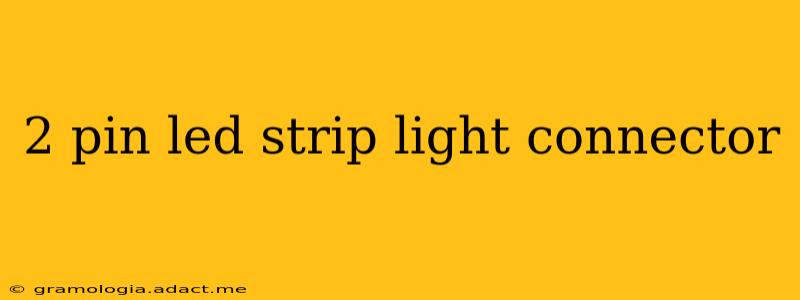Decoding the 2-Pin LED Strip Light Connector: A Comprehensive Guide
LED strip lights have revolutionized home and commercial lighting, offering versatility, energy efficiency, and a wide array of design possibilities. Understanding the connectors is key to successfully installing and maintaining these lights. This guide focuses specifically on the common 2-pin LED strip light connector, exploring its features, applications, and troubleshooting.
What is a 2-Pin LED Strip Light Connector?
A 2-pin LED strip light connector, as its name suggests, is a small connector with two pins designed to connect separate lengths of LED strip lights or to connect the strip to a power supply. These connectors are typically used with lower voltage LED strips, commonly operating at 12V or 24V DC. The two pins carry the positive (+) and negative (-) power lines, completing the circuit and illuminating the LEDs. They are usually found on non-addressable LED strips, meaning all LEDs along the length light up simultaneously. The simplicity of the 2-pin design contributes to its affordability and widespread use.
What are the different types of 2-pin connectors?
While the core functionality remains the same, variations exist in the physical design of 2-pin connectors. These differences can be based on factors such as:
-
Connector Style: You'll encounter various connector styles, including the common straight-through, right-angle, and even variations with locking mechanisms for improved security. The choice depends largely on the specific application and installation requirements. A right-angle connector, for instance, is useful in tight spaces where a straight connector might be cumbersome.
-
Wire Gauge: The thickness of the wires connecting to the connector dictates the maximum current it can safely handle. Thicker wires are needed for longer LED strip runs or higher power requirements. Choosing the correct gauge is crucial to prevent overheating and potential damage.
-
Connector Material: The connector housing can be made of various materials, including plastic (often ABS or PVC) and metal. The material selection affects durability, heat resistance, and cost.
How do I connect 2-pin LED strip lights?
Connecting 2-pin LED strips is generally straightforward. However, always ensure the power is OFF before working with any electrical components. Follow these steps:
-
Identify the Positive and Negative Wires: Most LED strips clearly mark the positive (+) and negative (-) wires. Pay close attention to these markings to ensure correct connection. Incorrect connection will likely result in the LED strip not working or potentially damaging the LEDs.
-
Prepare the Connectors: If the connectors aren’t already attached, carefully strip the insulation from the ends of the wires on your LED strip and securely attach them to the corresponding pins on the connector. A good quality solder joint is recommended for a durable and reliable connection.
-
Connect the Strips: Once the connectors are attached to both strips, simply plug them together, ensuring a secure connection. A slight click or snap usually indicates a successful connection.
-
Test the Connection: Before permanently installing, test the connection to ensure the LED strip is functioning correctly.
What are common problems with 2-pin connectors?
While generally reliable, certain issues might arise with 2-pin LED strip connectors:
-
Loose Connections: A loose connection is the most frequent problem, leading to flickering or complete failure of the LEDs. Ensure the connectors are securely plugged in. Check for corrosion or damage to the connector pins.
-
Incorrect Polarity: Connecting the positive and negative wires incorrectly will prevent the LEDs from lighting up. Always double-check the polarity markings before connecting the wires.
-
Overheating: Excessive current can overheat the connector and lead to melting or damage. Ensure the power supply and wiring are appropriate for the length and power consumption of the LED strip.
What are the alternatives to 2-pin connectors?
While 2-pin connectors are the most common, alternatives exist:
-
Soldering: For permanent connections, some prefer to solder the LED strips directly together. This eliminates the connector but requires soldering expertise.
-
Waterproof Connectors: Specialized waterproof connectors are available for outdoor or damp environment applications. These offer better protection from moisture.
-
Addressable LED Strip Connectors: If you're working with addressable LEDs (like WS2812B), you’ll need connectors compatible with their data signal lines in addition to the power lines.
By understanding the features, applications, and potential problems associated with 2-pin LED strip light connectors, you can successfully install and maintain your LED lighting projects. Remember safety first—always disconnect power before working on any electrical components.
